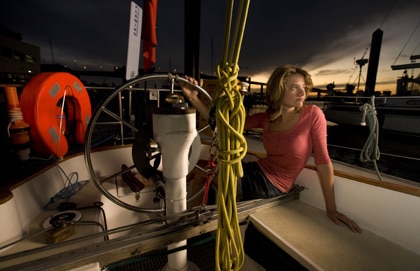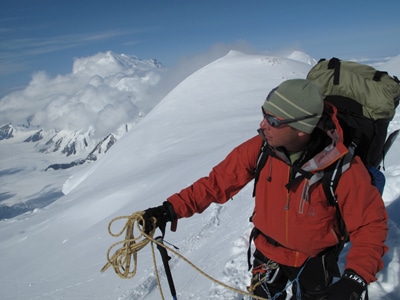Every December, National Geographic Magazine announces their “Adventurers of the Year” awards to honor those who push the boundaries of exploration, conservation, and adventure sports. Other magazines have followed suit over the years, and it is a time that I always look forward to; the profiles serve as a reminder that we don’t always have to look to men and women from the past for inspiration, for there will always be those boundless souls who “dream big” and accomplish amazing feats of physical and mental endurance. Among the many who made recent adventure headlines (from jungle pioneers to Antarctic explorers), we have chosen five to highlight here. In no particular order, they are: Ed Stafford, Jessica Watson, Eric Larson, David de Rothschild, and Andrew Skurka.
Ed Stafford – Amazon Explorer

Stafford, like many modern-day explorers, has the unique ability to blend adventure with philanthropy, using his expedition as an avenue to raise awareness of the environmental issues that plague the Amazon region. While he was in the military, he received his training in Central America and the Far East. In those places he witnessed the mass destruction of tropical forests from the endless expansion of unchecked agriculture, the illegal logging of old-growth trees, and the slash and burn decimation of acres and acres of jungle. His desire to accomplish a “world-first” and his passion for the environment led him on one of the most impressive adventures to date.
Stafford now has plans for another “world-first,” and though he will not divulge the details for fear of someone else beating him to the punch, he made a guarantee to Outside Magazine that it will be “bloody difficult.” He’ll set off for this new expedition next January.
*The true source of the Amazon is widely debated, and depending on where that source is, some argue that the Nile River is in fact the longest river in the world.
Jessica Watson – Circumnavigator
 Jessica Watson was eleven years old when she first heard the story of Jesse Martin, the 18-year old who, in 1999, became the youngest person to complete a non-stop, solo circumnavigation of the globe. The story stuck with her, and by the time she was thirteen she informed her parents that she intended to do the same thing.
Jessica Watson was eleven years old when she first heard the story of Jesse Martin, the 18-year old who, in 1999, became the youngest person to complete a non-stop, solo circumnavigation of the globe. The story stuck with her, and by the time she was thirteen she informed her parents that she intended to do the same thing.
Watson’s trip was controversial before it even began, with many critics fuming over the debate of “how young is too young?” She was too inexperienced, too immature, and far too young to endeavor into something so dangerous, they claimed. To add fuel to their fire, during a sea trial, her sailboat, Ella’s Pink Lady, collided with a 63-ton, 738-foot bulk carrier, which resulted in a broken mast that she had to tend to before her official launch. Having dealt with the problem successfully and with confidence, she later wrote that, “Any doubts about whether I could cope mentally…vanished.”
It wasn’t all smooth sailing after that first collision either; she experienced a “ferocious” Atlantic storm “with 4 knockdowns in one night…winds over 75 knots and waves of 15 meters and higher.”
Nevertheless, On March 15, 2010, after sailing for 210 days straight, Jessica Watson became the youngest person to circumnavigate the world–solo, unassisted, and non-stop. She completed her circumnavigation when she landed in Sydney Harbor three days before her seventeenth birthday. Yeah, she did this at the age of sixteen.
Since returning, a documentary film has been made about her voyage, and she has written a book titled True Spirit.
Eric Larson – Polar Explorer
 For fifteen years Eric Larson has been exploring the poles, adventure racing, and dog mushing. He is a man awed by the environments he encounters and drawn to frigid climates, with a personal motto of, “It’s cool to be cold.”
For fifteen years Eric Larson has been exploring the poles, adventure racing, and dog mushing. He is a man awed by the environments he encounters and drawn to frigid climates, with a personal motto of, “It’s cool to be cold.”
Throughout his years of adventuring, he has been witness to the rapid disappearance of the polar regions that he so loves. For this reason he began his Save the Poles project–a 365-day expedition to the “Polar Trifecta.” That is, the South Pole, the North Pole, and the summit of Mount Everest. This was an unprecedented, single-year tour-de-force beginning in November of 2009 and concluding in October of 2010. Braving -50 degree temperatures, Larson snow-shoed, skied, and swam across the Arctic, all while gathering scientific data and filming a documentary as he went. He braved whiteouts in Antarctica and avoided avalanches on the formidable slopes of Everest. He traveled along thinning Arctic ice that would bend and fracture underneath his team’s skis and campsites, sometimes “opening [up] gaping holes of icy water near where they slept,” reported Outside Magazine.
“On an expedition, there is you and there is ice (or rocks or water) and doing a long carry, skiing into the wind, waiting for weather and more can all make time slow to a crawl. Minutes seem like hours. Days seem like weeks. It can be agonizing on a good day.”
David de Rothschild – Voyager
As the youngest heir to his family’s banking fortune, Rothschild is not a person who uses his wealth as an excuse to be stagnant. His adventure accomplishments are vast: In 2006, he was the youngest British citizen to ever reach both geographical poles after spending 100 days crossing the Arctic from Russia to Canada. Prior to that, he had been part of a team who claimed the record for the fastest crossing of the Greenland Ice cap, and he is one of only fourteen people to ever traverse Antarctica.
Like Stafford, Larson, and other current explorers, David de Rothschild’s focus is to raise awareness about various environmental issues that are threatening the world’s natural wonders. Named one of the “Adventurers of the Year” by National Geographic Magazine, his most recent trip was a Pacific Ocean crossing aboard “Plastiki,” a catamaran made almost entirely of recycled plastic material, including some 1,200 plastic bottles. Batteries powered by solar energy charged Plastiki’s electrical components, and fresh water was made possible by a small, onboard desalination device. The mission of the expedition was to reach and study “Plastic Island,” a floating swath of garbage that has accumulated in the mid-Pacific ocean, believed to be nearly twice the size of the state of Texas.
De Rothschild announced the idea four years prior to the actual launch of Plastiki. In the spring of 2010, Plastiki and the crew sailed into the Pacific Ocean. They traveled 9,500 miles, visited various points of ecological interest, and then on July 26th, 2010, they completed their journey when they reached Sydney Harbor, greeted by cheering crowds.
Andrew Skurka – Alaska-Yukon Explorer
“My primary goal in attempting the AYE is unabashedly personal: I want an exceptionally unique, rewarding, and challenging experience…it makes me feel alive, like I am capitalizing on the 70-or 80-year-long opportunity I have to experience this world.”
The Alaska-Yukon Expedition (AYE) is Skurka’s most recent and perhaps boldest expedition yet. A circumnavigation of some of Alaska’s most rugged wilderness, the nearly 4,700-mile route included traverses of the Alaska and Brook’s Ranges, winded through six US national parks, two Canadian parks, and involved floats on “some of America’s wildest rivers, including the Copper, Yukon, Peel, and the Kobuk River.” Some 45% of the route was off-trail and still he managed to average 27 miles per day. Though most of the route had been previously explored, Skurka’s was the first attempt at doing it all in one big push.
By beginning in March of 2010, he was able to avoid some of the toughest of the Arctic’s winter; still, approximately 24% (over 1,000 miles) of the trip had to be covered on skis along the Iditarod Trail and in the Alaska Range until the spring snowmelt came. The remaining time was spent hiking and rafting (his raft was a 4.5-pound, blow-up “whitewater-worthy” packraft) in unruly country known for its bears, snow, raging rivers and a sheer immensity unlike anything in the lower 48.
Despite his significant previous experience (such as the 7,775-mile sea-to-sea epic he completed in 2005) Skurka told Adventure Running, that for this trip he was “more scared than [in] all of [his] previous trips combined.” At one point he had gone over 650 miles without seeing another human, and in the Yukon, he was “3-4 hours from the nearest settlement…by helicopter,” making for a nerve-wracking and stressful journey. Nevertheless, on September 5, 2010, he walked into the tiny town of Kotzebue 176 days after he had first left, as the first person to complete the route.
Be sure to listen to our podcast with modern-day adventurer Laval St. Germain:








